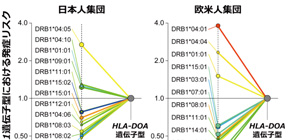
Involvement of non-classical HLA genes in rheumatoid arthritis clarified
A risk of development of HLA-DOA genes identified through HLA imputation
An international joint research group led by Team Leader YAMAMOTO Kazuhiko, Laboratory for Autoimmune Diseases, Center for Integrative Medical Sciences (IMS), RIKEN, and Professor OKADA Yukinori at the Graduate School of Medicine, Osaka University, clarified that HLA-DOA, a non-classical human leukocyte antigen (HLA) gene, was involved in the onset of rheumatoid arthritis (RA), an auto-immune disease that causes inflammation and loss of function in the joints.
Individual genetic factors are related to the onset of RA and many disease susceptibility genes have been reported through large-scale genome analysis. It was known that the HLA gene that determines the blood type of leukocytes had a high risk of developing RA; however, which HLA gene was involved in the onset of RA was not clear due to the HLA gene having multiple types and the complexity of HLA gene structures.
This international joint research group conducted big data analysis for some 60,000 individuals in the Japanese, Asian, and European populations via HLA imputation that exhaustively analyzed HLA gene sequences through use of supercomputers. As a result, it was found that HLA-DOA genes were involved in the onset of RA and that the gene sequence that enhanced the risk of developing RA reduced expression of HLA-DOA. From the comparison of the risk of developing RA in HLA-DOA gene types by race, the highest risk was observed in the Japanese population.
In previous disease genome research, primarily classical HLA genes, which are the principal genes of HLA genes, were analyzed, leaving non-classical HLA genes not well understood. The clarification of the involvement of HLA-DOA, a non-classical HLA gene, in the onset of RA will promote the understanding of the role of non-classical HLA genes in the future. This achievement will lead to the realization of personalized (custom-made) medicine based on personal genetic information, as well as the development of new therapeutic medicines.
Abstract
Despite the progress in human leukocyte antigen (HLA) causal variant mapping, independent localization of major histocompatibility complex (MHC) risk from classical HLA genes is challenging. Here, we conducted a large-scale MHC fine-mapping analysis of rheumatoid arthritis (RA) in a Japanese population (6,244 RA cases and 23,731 controls) population by using HLA imputation, followed by a multi-ethnic validation study including east Asian and European populations (n = 7,097 and 23,149, respectively). Our study identified an independent risk of a synonymous mutation at HLA-DOA, a non-classical HLA gene, on anti-citrullinated protein autoantibody (ACPA)-positive RA risk (p = 1.4 × 10 −9 ), which demonstrated a cis-expression quantitative trait loci (cis-eQTL) effect on HLA-DOA expression. Trans-ethnic comparison revealed different linkage disequilibrium (LD) patterns in HLA-DOA and HLA-DRB1, explaining the observed HLA-DOA variant risk heterogeneity among ethnicities, which was most evident in the Japanese population. Although previous HLA fine-mapping studies have identified amino acid polymorphisms of the classical HLA genes as driving genetic susceptibility to disease, our study additionally identifies the dosage contribution of a non-classical HLA gene to disease etiology. Our study contributes to the understanding of HLA immunology in human diseases and suggests the value of incorporating additional ancestry in MHC fine-mapping.
Figure 1. Biological roles of HLA genes to the risk of rheumatoid arthritis.
Human leukocyte antigen (HLA) genes play important roles in regulation human immune system. HLA genes consist of two major categories of classical HLA genes and non-classical HLA genes. Contribution of amino acid sequence mutations of the classical HLA genes, such as HLA-DRB1 , HLA-DPB1 , and HLA-B , to the risk of rheumatoid arthritis (RA) has been known. In this study, the researchers newly identified that expression dosage changes of the non-classical HLA gene, HLA-DOA , also contributes to the risk of RA.

Figure 2. Connection between the HLA-DRB1 gene mutation and the HLA-DOA gene mutation.
The HLA-DRB1 gene mutations have strong RA risk in multiple populations. In the European populations, the HLA-DRB1 gene mutations with RA risk were tightly connected to the HLA-DOA gene mutation with RA. In contrast, these mutations were relatively loosely connected in the Japanese population, which enabled to successfully observe the HLA-DOA mutation risk independent of the HLA-DRB1 mutation risk in Japanese.
To learn more about this research, please view the full research report entitled “Contribution of a non-classical HLA gene, HLA-DOA, to the risk of rheumatoid arthritis” at this page of the American Journal of Human Genetics website.
Related link

